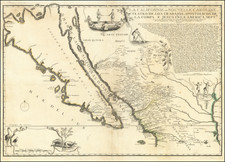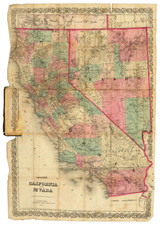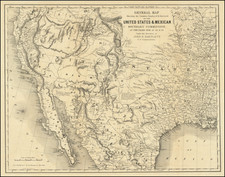Rare early promotional brochure, promoting travel to the Yosemite Valley, the Calaveras Big Trees, and the Geysers of Calistoga, California, published by Thomas Houseworth & Co.
The map shows the routes from San Francisco, San Jose, Oakland and Sacramento to California's earliest major tourist destinations, along with promotional information. The routes extend to the Virginia City area, which was then among the most prosperous mining boom towns in America, along with Aurora, Nevada, another major mining boom town. The map also identifies the Mariposa Big Tree Grove, the Tuolomne Big Trees and other points of interest. Lake Bigler is now called Lake Tahoe.
The promotional brochure is quite rare, with only 2 examples located (Yale and Huntington Library).
The Library of Congress holds the Lawrence & Houseworth photograph collection. Thomas Houseworth & Co. was the successor to the firm of Lawrence & Houseworth, one of the earliest and most important sellers of optical views and stereographs in California. As noted by the Library of Congress on line exhibition on the firm:
George S. Lawrence (dates unknown) and Thomas Houseworth (1828-1915) sailed from New York City to San Francisco on April 4, 1849. They were headed for the California gold mines. For the next two years they worked as miners in Calaveras and Trinity Counties.
In 1851 Lawrence and Houseworth left the mines and settled in San Francisco where Lawrence sold jewelry. A short time later, he opened an optical shop opposite Portsmouth Plaza. In 1855 Houseworth joined the business. Many years later, Houseworth recalled that it was the first optical shop on the West Coast. Their advertisements promoted imported optical, mathematical and philosophical instruments, Joseph Rodgers & Son's cutlery, magic lanterns, billiard balls, and chalk.
In 1859 Lawrence & Houseworth added stereographs to their inventory. Their stock included images from around the world published by the London Stereoscopic Company, as well as a small group of views documenting Nevada and California. As a way to entice the public, the store displayed the stereographs in their windows. . . .
Capitalizing on the growing market for stereographs, in 1863 Lawrence & Houseworth decided to publish views under their name and made a concerted effort to acquire more photographs. They advertised their desire to purchase stereoscopic negatives of the Pacific Coast. Photographer Charles Leander Weed provided the company with three series of negatives: Sacramento during the Great Flood of 1862; Silver Region, Nevada Territory; and A Trip to Washoe. At this time, Lawrence & Houseworth also hired Weed to make photographs of Yosemite Valley, the trade routes east of Sacramento, and Native Americans in the Sierra foothills. Alfred A. Hart, the official photographer of the Central Pacific Railroad, may have supplied the firm with negatives of hydraulic mining operations in the Sierras.
Lawrence & Houseworth's inventory grew and the firm soon offered the largest collection of stereographs on the Pacific Coast. Their inventory for California alone numbered more than one thousand different views. As might be expected, the company offered numerous views of California's largest cities, San Francisco and Sacramento. These photographs documented hotels, businesses, private residences, and street scenes, including views of San Francisco's Chinatown. In addition, the firm offered extensive documentation of the mining regions of California and Nevada. These boom towns had catchy names like Gold Hill, Dutch Flat, Timbuctoo, Drytown, Hope Valley, and Volcano.
George S. Lawrence retired from the business in 1868 and the firm was renamed Thomas Houseworth & Company. The company was always in need of new photographs to document the growth and change of the region. Charles Weed, who had previously made numerous photographs for the firm, had moved his studio to Hong Kong, so Houseworth commissioned the photographer Eadweard Muybridge to make a set of mammoth plate photographs of Yosemite. Meanwhile, another local firm, Bradley & Rulofson, also approached Muybridge about his Yosemite views. In the end, the views were published by Houseworth's competition. To make matters worse, the San Francisco press covered the squabble between Houseworth and Bradley & Rulofson. This publishing fiasco left Houseworth in debt and damaged his reputation.
The 1870s saw a increase in the number of firms publishing stereographs. Even East Coast publishers offered views of Yosemite and other western locations and prices for stereographs plummeted. Houseworth cut back on the number of stereographs that he offered for sale. He took up photography, primarily working as a portrait photographer, as a way to gain a new audience. He photographed celebrities and promoted their portraits through an illustrated catalog.











![[ The Ptolemaic Universe ] Situs Terrae Circulis Coelestibus Circundatae . . .](https://storage.googleapis.com/raremaps/img/small/101512.jpg)


![[ Before The Salton Sea ] [ Official Map of San Diego County compiled from latest official maps of U.S. surveys, railroad and irrigation surveys, county records, and other reliable sources . . . Northeast Sheet ]](https://storage.googleapis.com/raremaps/img/small/101378.jpg)